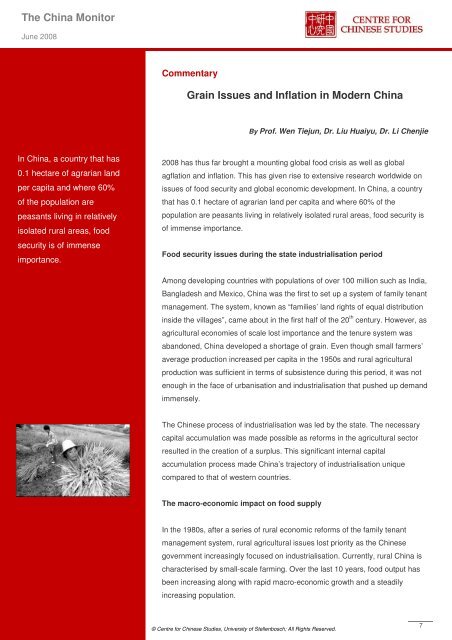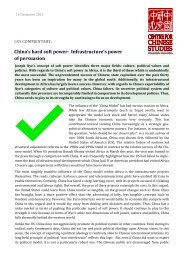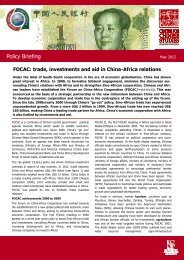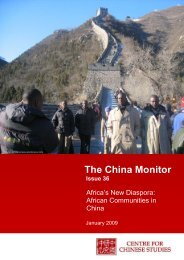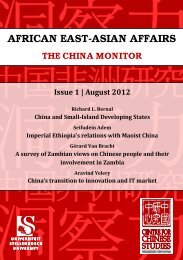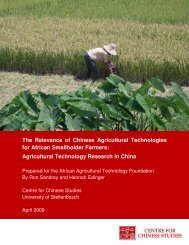The China Monitor - The Centre for Chinese Studies
The China Monitor - The Centre for Chinese Studies
The China Monitor - The Centre for Chinese Studies
Create successful ePaper yourself
Turn your PDF publications into a flip-book with our unique Google optimized e-Paper software.
<strong>The</strong> <strong>China</strong> <strong>Monitor</strong>June 2008CommentaryGrain Issues and Inflation in Modern <strong>China</strong>By Prof. Wen Tiejun, Dr. Liu Huaiyu, Dr. Li ChenjieIn <strong>China</strong>, a country that has0.1 hectare of agrarian landper capita and where 60%of the population arepeasants living in relativelyisolated rural areas, foodsecurity is of immenseimportance.2008 has thus far brought a mounting global food crisis as well as globalagflation and inflation. This has given rise to extensive research worldwide onissues of food security and global economic development. In <strong>China</strong>, a countrythat has 0.1 hectare of agrarian land per capita and where 60% of thepopulation are peasants living in relatively isolated rural areas, food security isof immense importance.Food security issues during the state industrialisation periodAmong developing countries with populations of over 100 million such as India,Bangladesh and Mexico, <strong>China</strong> was the first to set up a system of family tenantmanagement. <strong>The</strong> system, known as “families’ land rights of equal distributioninside the villages”, came about in the first half of the 20 th century. However, asagricultural economies of scale lost importance and the tenure system wasabandoned, <strong>China</strong> developed a shortage of grain. Even though small farmers’average production increased per capita in the 1950s and rural agriculturalproduction was sufficient in terms of subsistence during this period, it was notenough in the face of urbanisation and industrialisation that pushed up demandimmensely.<strong>The</strong> <strong>Chinese</strong> process of industrialisation was led by the state. <strong>The</strong> necessarycapital accumulation was made possible as re<strong>for</strong>ms in the agricultural sectorresulted in the creation of a surplus. This significant internal capitalaccumulation process made <strong>China</strong>’s trajectory of industrialisation uniquecompared to that of western countries.<strong>The</strong> macro-economic impact on food supplyIn the 1980s, after a series of rural economic re<strong>for</strong>ms of the family tenantmanagement system, rural agricultural issues lost priority as the <strong>Chinese</strong>government increasingly focused on industrialisation. Currently, rural <strong>China</strong> ischaracterised by small-scale farming. Over the last 10 years, food output hasbeen increasing along with rapid macro-economic growth and a steadilyincreasing population.© <strong>Centre</strong> <strong>for</strong> <strong>Chinese</strong> <strong>Studies</strong>, University of Stellenbosch; All Rights Reserved.7


